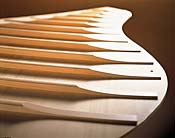
THE SOUND BOARD
Like the speaker of a radio, a piano's sounding board is a vibrating diaphragm. To work properly, the board must always be under tension. This is accomplished by having the center of the board arched, or crowned, with the strings pressing down on the board where they cross the bridges. The vibrations of the strings are thus transmitted through the bridges to the sounding board, where they are greatly amplified by the board and projected into the air to reach our ears.
The piano string acts as a tone generator. The sounding board's function is to truly reflect and amplify that tone. The sounding board is the most important single part in the piano because if the board is bad, you do not have a piano until there has been a major repair job. No real music can come out of a conventional piano except through the sounding board. So that it will vibrate freely, a sounding board is necessarily a very thin panel, usually from 3/16 to 3/8 of an inch thick. Ribs are added to stiffen the board and to help preserve the crown. The reason the ribs are shaped at the ends is to allow the board more flexibility around its perimeter. Until recent years, all piano sounding boards were made of solid lumber pieces glued edge to edge. Wood, however, has an irresistible tendency to absorb or lose moisture according to the humidity content of the surrounding air. Absorption of moisture causes the conventional sounding boards to expand, increasing the tension of the strings and, thus, raising the pitch. Conversely, the pitch is lowered when the board dries out. It has been a constant struggle to try to keep such sounding boards from splitting or from losing their all-important crown. To obtain perfect musical results, there must be good contact between each of the strings and the board. This perfect contact cannot be maintained if the board loses all, or even part, of its convex form (crown). Piano sounding boards are made of wood because no other known material amplifies musical tones so well.
THE SOUNDBOARD
1. The soundboard consists of a sheet of wood;
* One thickness spruce (the term "solid" when referring to spruce soundboards is very often misleading today because some builders of pianos with laminated boards where all three layers are spruce, refer to soundboards as "solid" spruce meaning they are all spruce).
* Special taper. Starting from 6 to 9mm at the at edges (three eights of an inch thick and beveled) as a resonator.2. The soundboard is not flat as it appears. but has a crown held in place by a series of ribs. If the soundboard were flat or if it were to lose this crown, there would be very little volume or tone.
* The ribs are made of a lightweight wood such as sugar pine, are double notched and fitted into soundboard lining. * They are tapered to fit and correspond with the taper of the soundboard.
3. Bridges, made from maple, must be planed to exact thickness from end to end, so as to provide the proper down bearing of the strings upon the bridges, this is measured by the use of a "bearing gauge" (See Glossary of Piano Terms).
* Bridges are glued and further secured to the soundboard.
* To prevent vibrations bridges are secured with wood screws that have maple buttons under their heads.
* Bridges are double notched.
* Bass bridge cantilevered.
"THE SOUNDBOARD OF THE PIANO"
From an article by Dr. William Braid White,
Principal of the School of Pianoforte Technology, Chicago, Ill.,
Reprinted from the Piano Trade Magazine, Chicago, Ill."IN THE PIANO the function of the soundboard is to take up and repeat the vibratory motions of the strings, and thus to set up in the air sound waves of vastly greater size and power than could be generated by the strings alone. The more faithfully the sound-board performs this function, the better soundboard it is. The layman will better understand this amplifying function of the soundboard if he will think of the relatively enormous area of the board when compared with the very small area of all the strings taken together. Hence, when the piano is played, the soundboard, repeating the vibratory motions of the strings, sets in vibration vastly more air than could the strings themselves.
The more than two hundred strings that constitute the tone-generating element of the piano are stretched, at high tensions, over wooden bridges, or supports, which are rigidly fastened to the surface of the soundboard. Thus, within a small fraction of a second any motions of the strings are transmitted through the bridges to the soundboard, which as it were, accepts them, and faithfully reproduces them over its entire surface. These tiny but intensely complex motions, originating at the strings, are transmitted to the large body of air surrounding the front and back surfaces of the soundboard, thereby setting up powerful sound waves which immediately register on the ear-drums of all within hearing.
So faithfully does the sound. board perform this difficult function, that no matter how many strings may be sounding at one time, their almost incredibly complex motions will always and un-failingly be taken up and reproduced. Thus, the soundboard of the piano acts just as does the parchment head of a drum or the thin steel diaphragm of the receiver element in a telephone. It should be remembered, however, that it is the strings, and not the soundboard, that originate, by their vibratory motions after they have been struck, the sound which the soundboard amplifies.
In order to obtain these very remarkable effects of amplification, the soundboard of the piano must be constructed with exquisite skill. Its length and breadth depend of course, upon the size of the instrument, while its thickness, with some variations between one end and the other, averages one-quarter inch. The pieces of spruce wood from which it is made are matched in such a way that the grain runs roughly parallel to the line of the great bridges upon which the strings rest.
FACTS LITTLE UNDERSTOOD
It is strange but true that these simple facts about the effect of the strings upon the sound board and about the soundboard's responses to the strings, are still very little understood. Thus there persists a common notion that a crack in the wood must in some way cause a deterioration of the tonal output. Actually, no such effect is to be expected. The erroneous idea that a crack in a soundboard reduces the tonal output is undoubtedly due to the equally erroneous theory that sound "vibrations" in some way travel transversely across the soundboard. But, as has been shown here, the movement of the board is that of the movement of the strings, up and down in the case of a grand, backward and forward in the case of a piano of vertical construction. The glued-up strips of thin spruce, reinforced by bridges and ribs, which constitute the soundboard, become in fact a single unit, so that the whole board vibrates with the playing of even one single note anywhere in the scale.
EFFECT OF CRACKS AND CHECKS
For this very reason a crack or check in a soundboard reduces the soundboard's ability to amplify the vibrations of the strings only to the extent to which the crack reduces the vibrating area of the board.
Soundboard areas vary with the size of various pianos, but consider for example a board with an area of 4,000 square inches, counting both surfaces. Now assume that there is a crack in this board 35 inches long and one eighth inch wide, which would be an enormous crack. That crack would have an area (counting both surfaces) of 8 3/4 inches, and so would reduce the air disturbing area of the board by less than of one per cent, all amount utterly negligible. Here we have considered the effect of an enormously big crack. A dozen ordinary cracks, even if they extended from end to end of the soundboard, might have about as much effect, certainly no more. So long, in fact, as the structure of the soundboard re-mains solid, with ribs and bridges adhering correctly to the surface of the soundboard, and with the entire periphery rigidly fastened into the frame of the piano, the question of cracks is utterly unimportant. "
Dr. William Braid White
THE EFFECT OF ATMOSPHERIC CHANGES IS OF GREATER IMPORTANCE
As a matter of fact, the tonal output of any piano, with no cracks in the soundboard at all, is subject to vastly greater change with every change in temperature and humidity. The alternate absorption and evaporation of moisture affects the soundboard, and therefore the tone of the piano, to a far greater degree than any crack or accumulation of cracks, yet few persons complain of this or even appear to notice it.
Wood is used for sounding boards because countless tests by several generations of piano builders and technicians using steel, aluminum and other materials proved that wood best reflects the tonal waves or vibrations transmitted by piano strings. Once this fact was accepted, it became a problem of how to make the wood "behave" so that the sounding board would approach being as durable as the rest of the piano instead of being one of its weakest parts.
PIANO AGE | ARCHIVES | APPRAISALS | PIANO TYPES | BLUEBOOK VALUE | SELL A PIANO
Copyright © 2015 Bluebook of Pianos All Rights Reserved - Copyright laws exist to protect our intellectual property. They make it illegal to reproduce someone else's expression of ideas or information without permission. At one time, a work was only protected by copyright if it included a copyright trademark (the © symbol). According to laws established in 1989, however, works are now copyright protected with or without the inclusion of this symbol. Anyone who reproduces copyrighted material improperly can be prosecuted in a court of law. It does not matter if the form or content of the original has been altered -- as long as any material can be shown to be substantially similar to the original, it may be considered a violation of the Copyright Act.
